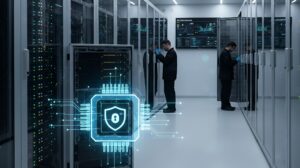The global maritime shipping industry is embarking on an unprecedented transition. This is from conventional bunker fuels to low and zero-carbon alternative energy sources. It includes liquefied natural gas (LNG), methanol, biofuels, hydrogen, ammonia, batteries, wind power, and nuclear. So, this energy transformation is essential for the industry. It helps meet greenhouse gas reduction targets set by the International Maritime Organization (IMO) and aligns with global decarbonization goals. This answers the much-asked question of what is alternative fuel infrastructure.
However, the widespread adoption of modern clean fuels critically depends on proactive and extensive infrastructure upgrades. These are undertaken across ports worldwide. So, as vital interfaces between visiting ships and their fuel supply chains, ports play an indispensable role. This is in enabling the integration of emerging alternative fuels into marine bunkering. As a result, without proper port infrastructure to deliver, store, handle, and supply of sustainable new fuels, the transition to cleaner energy sources within the massive global shipping industry cannot fully succeed.
This article examines the key infrastructure investments and modifications that will need to be implemented at ports. That too around the world to support the shift to low and zero-carbon alternative bunker fuels for greener maritime transport.
Port Infrastructure Upgrade: Expanding LNG Bunkering Infrastructure
Liquefied natural gas (LNG) is growing rapidly as a cleaner transitional marine fuel. It can reduce ship emissions. Moreover, investing in expanded LNG bunkering infrastructure is a priority for many ports seeking to support LNG-powered vessels. So, key infrastructure requirements are:
LNG Import and Regasification Terminals
Mega-scale shoreside import and processing terminals should be there to enable LNG bunkering. It allows the centralized receiving and regasification of LNG transported by tankers. Furthermore, these massive facilities which cost over $500 million each require multiple elements.
These elements are jetties, insulated cryogenic LNG storage tanks, regasification units, and interconnecting pipelines. So, leading LNG bunkering ports like Rotterdam, Singapore, and Abu Dhabi have already installed large import terminals.
Dedicated LNG Bunkering Facilities
Specialized shoreside facilities that allow safe ship-to-ship transfer of LNG. This is via bunker barges or direct fueling arms. Moreover, critical components are cryogenic piping, pumping systems, jetties, and monitoring/control equipment. These are tailored for LNG. Additionally, Jacksonville, Zeebrugge, and Gothenburg already operate dedicated LNG bunkering facilities.
Comprehensive LNG Safety Infrastructure
In addition to handling equipment, comprehensive LNG safety systems encompassing operator training, cryogenic leak monitoring, setback distances, and emergency shutdown are mandatory. This is when dealing with cryogenic natural gas.
Port Infrastructure Upgrade: Deploying Shore Power Infrastructure
Shore power, the process of docked vessels drawing electricity from portside grids, is an attractive zero-emissions solution. However, ports must build extensive high-voltage power transmission infrastructure. It helps to deliver shore power. So, let us look at some key shore power infrastructure:
High Voltage Shore Connection Substations
These submarine-rated substations interface between port grids and ships, transforming and transmitting high-voltage shore power customized to match ship systems. Moreover, the Port of Long Beach has invested heavily in shore power substations.
Kilometer-Scale Shore Power Cables
Thick submarine cables safely convey high-voltage power. This is from substations to docked ships through standardized berth link boxes. Moreover, major upgrades are underway at leading shore power ports like Busan, Los Angeles, and Vancouver.
Voltage Transformers
Critical step-down shore power transformers reduce the high shore voltage. This is to standardize 440V or 6.6kV levels for onboard use, like those at the Port of Gothenburg.
Port Infrastructure Upgrade: Biofuel Storage, Handling, and Bunkering Infrastructure
Biofuel blends are a promising lower carbon fuel oil substitute requiring tailored infrastructure:
Dedicated Biofuel Storage Tanks
Due to their unique properties, biofuels require custom storage tanks with coatings and heating systems. It helps maintain stability and also prevents degradation during storage.
Modified Piping for Biofuel Resistance
Most conventional port piping needs upgraded seals, linings, and materials. These should be resistant to biofuel corrosion. Moreover, Singapore has modified pipelines using FBE coatings to handle biofuels.
Quality Control Labs
Specialized metrology labs and equipment require investments to rigorously test biofuel blends before bunkering. It should consider the propensity for contamination and variable fuel specifications.
Safety Upgrades
The high reactivity of many biofuels may demand enhanced fire suppression. It might also require electrical grounding, ventilation, and worker safety gear during handling.
Port Infrastructure Upgrade: Hydrogen and Ammonia Bunkering Infrastructure
As potential future carbon-neutral fuels, adopting hydrogen and ammonia requires specialized handling and storage infrastructure:
Hydrogen Production, Storage, and Bunkering Facilities
The requirements are onsite hydrogen production units, heavily reinforced storage tanks, cryo-compressors, and special bunkering interfaces. Moreover, it helps to deliver pressurized or cryogenic liquid hydrogen fuel.
Ammonia Import Terminals
Ammonia requires cryogenic (-28°F) receiving and storage tanks. It also requires bunkering systems suited for the corrosive liquid and strict environmental safety protocols.
Rigorous Hydrogen and Ammonia Safety Systems
Extensive ventilation, hazard containment, leak detection, fire prevention, and worker safety systems are crucial. This is when managing the explosive and toxic risks inherent in hydrogen and ammonia bunkering.
Port Infrastructure Upgrade: Battery Container Handling Infrastructure
Containerized electric battery propulsion demands tailored port infrastructure:
High Power Charging Stations
Quick recharging of multi-ton battery containers. This is before loading requires high-capacity direct current charging stations.
Specialized Container Lifting and Handling Gear
Ports need reinforced forklifts, cranes, and straddle carriers. Moreover, these should safely lift heavy 40-ton battery containers between ships and charging areas.
Safe Battery Storage Facilities
Companies need temperature-controlled battery container warehouses with fire suppression and sophisticated battery management systems. Furthermore, it helps in safe charging and storage.
Comprehensive Battery Handling Training and Protocols
Extensive training on safe battery movement, hazards, fire risks, and charging is essential. This goes for port workers along with robust handling protocols.
Port Infrastructure Upgrade: Overcoming Deployment Challenges
While vital for unlocking the potential of clean fuels, upgrading port infrastructure faces challenges. It includes high upfront capital costs, fuel uncertainty, coordination complexities, and space constraints at congested ports. So, creative financing models, policy incentives, public-private partnerships, and bold visions among ports and governments can help overcome hurdles. It can also help accelerate alternative fuel infrastructure readiness.
The CO2 emissions imperatives facing global shipping make a future based on alternative bunker fuels inevitable. As a result, ports worldwide must proactively upgrade infrastructure to meet the urgent need for cleaner propulsion. This is to offer the storage capacity, delivery mechanisms, and bunkering capabilities. They are demanded by low-carbon marine fuels. We hope your question of what is alternative fuel infrastructure and its challenges are easier to navigate now. You can also attend the upcoming summit by Future Bridge which aims to cover all topics related to ports and harbours right from the experts. Let’s know more.
The Net Zero Ports & Harbours Summit, 2024
The upcoming Net Zero Ports & Harbours Summit in Barcelona, Spain on March 14-15, 2024 provides an excellent opportunity for ports. This is to gain insights into the port infrastructure upgrades and best practices. They are needed to support sustainable alternative marine fuels.
With a solutions-focused agenda, industry-leading speakers and attendees, and invaluable networking opportunities, the summit provides ports with an unparalleled overview of port infrastructure investments. It helps transition to a future based on clean fuel bunkering. So, port authorities and operators looking to spearhead the adoption of alternative fuels are strongly encouraged to register for this timely event.



